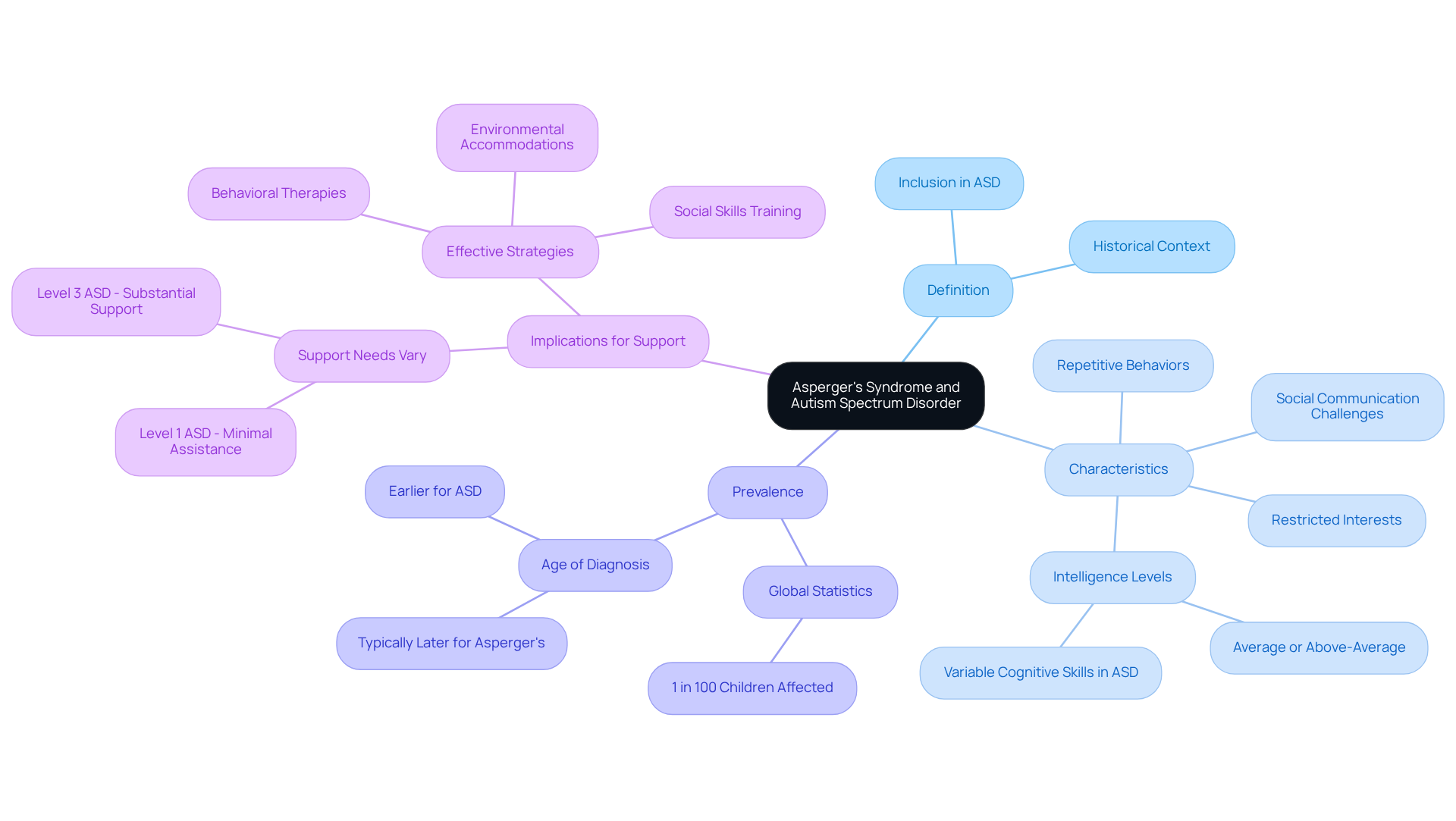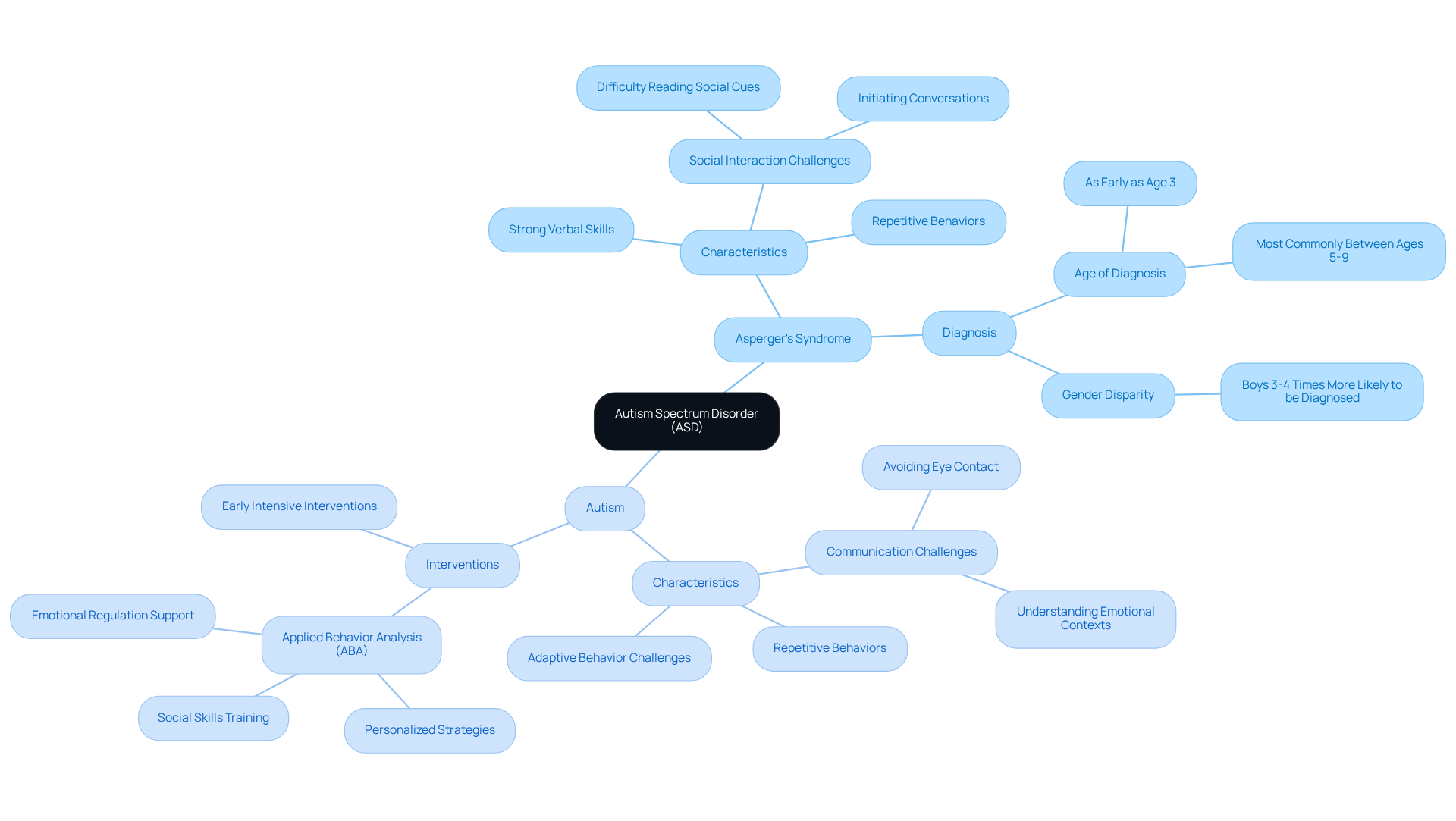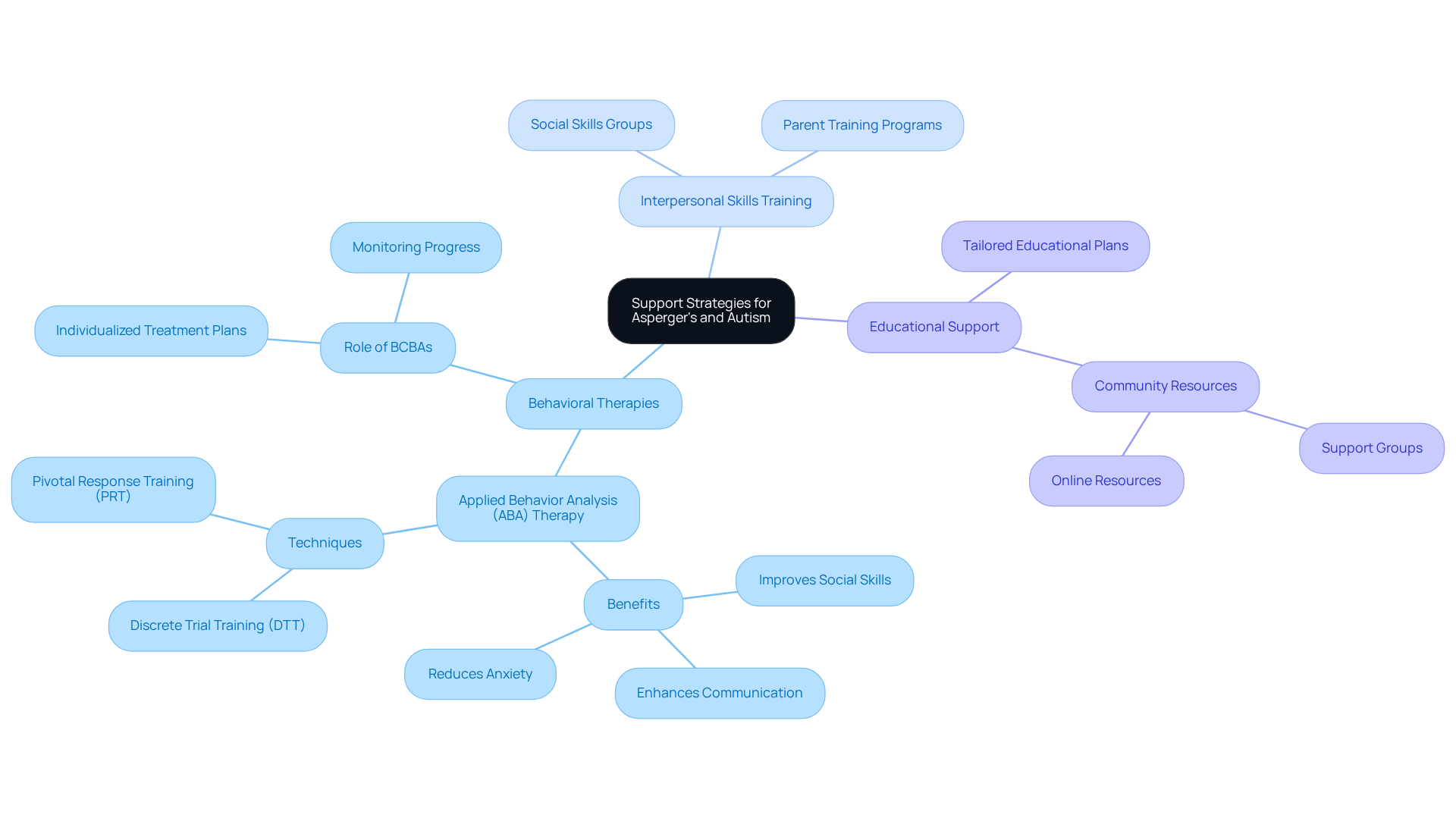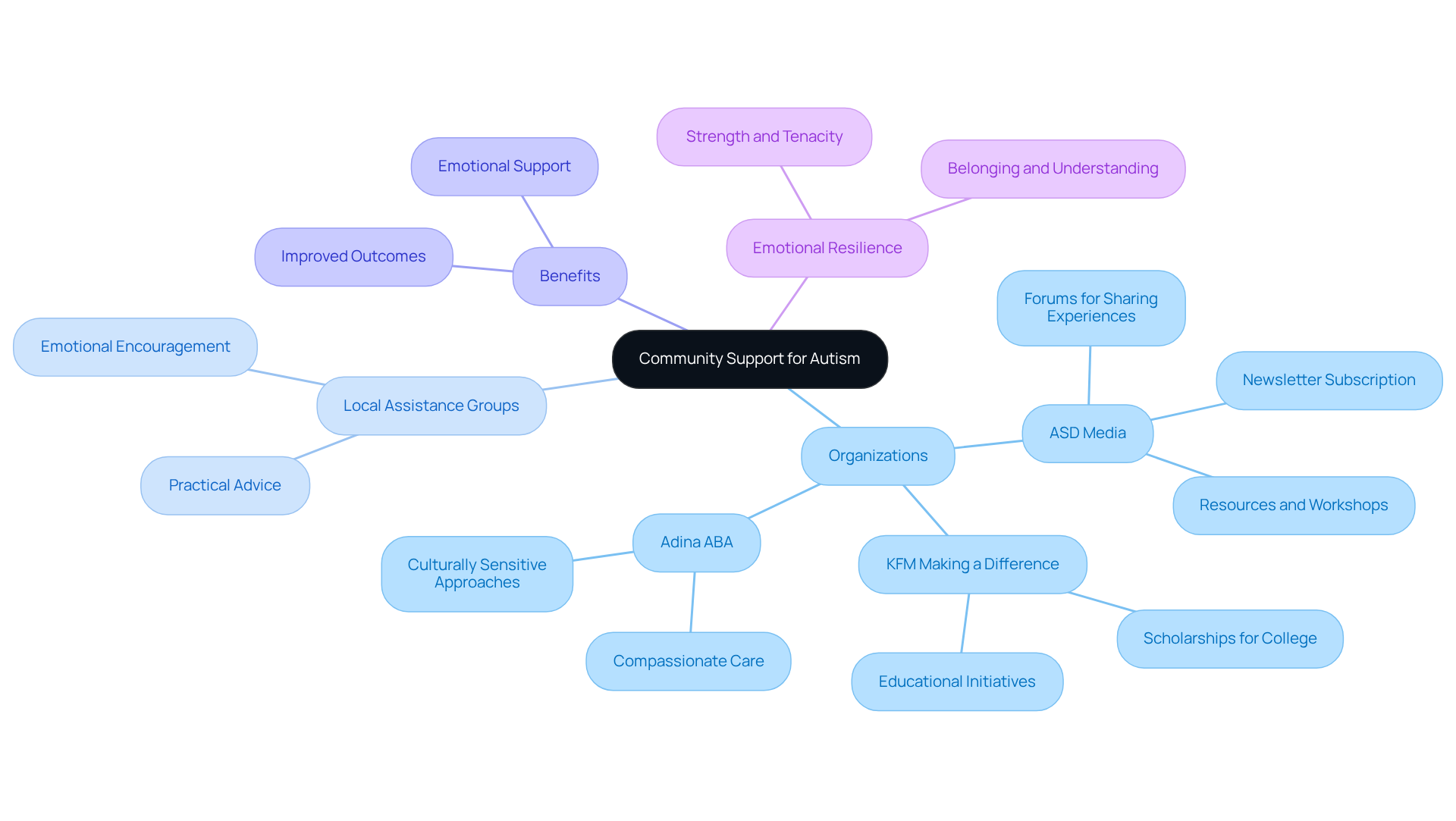Overview
This article shines a light on the important distinctions between Asperger's Syndrome and Autism Spectrum Disorder (ASD), while also offering effective support strategies for those affected by these conditions.
It’s essential to recognize that, although Asperger's is now categorized under ASD, individuals can display a wide range of symptoms and support requirements. This variability underscores the necessity for personalized interventions, such as Applied Behavior Analysis (ABA) therapy, which can significantly enhance communication and social skills.
By understanding these differences and implementing tailored strategies, we can better support individuals on their unique journeys.
Introduction
Understanding the nuances between Asperger's syndrome and Autism Spectrum Disorder (ASD) is vital in today’s evolving landscape of neurodevelopmental diagnoses. With approximately 1 in 100 children affected globally, recognizing the distinct characteristics and support needs of individuals on the spectrum can profoundly influence their development and quality of life.
However, as definitions and classifications continue to shift, how can parents and professionals effectively navigate this complex terrain to provide the best support? This article explores the key differences, symptoms, and tailored strategies that can nurture meaningful growth for those with Asperger's and autism. It also addresses the critical question of how to ensure that every individual receives the appropriate resources and understanding they truly deserve.
Define Asperger's Syndrome and Autism Spectrum Disorder
Asperger's syndrome and autism, which was once recognized as a distinct diagnosis, is now encompassed within Autism Spectrum Disorder (ASD) according to the DSM-5. This neurodevelopmental disorder affects approximately 1 in 100 children globally, manifesting as challenges in social communication, restricted interests, and repetitive behaviors. Typically, this syndrome describes individuals exhibiting milder symptoms, often possessing average or above-average intelligence and showing no significant delays in language development.
As Tim Jewell insightfully notes, 'Asperger's syndrome and autism are now considered part of the autism spectrum and are no longer diagnosed as separate conditions.' Understanding these definitions is vital for parents and professionals navigating the complexities of diagnosis and treatment options in the context of ABA therapy. It's also important to acknowledge that support needs can vary widely among individuals on the spectrum, which significantly influences the approach to effective support strategies.

Compare Symptoms of Asperger's and Autism
Understanding Autism Spectrum Disorder (ASD) is essential, especially when considering that approximately 1 in 68 children may be affected. Individuals with ASD can face significant challenges in interpersonal interactions, communication, and may exhibit repetitive behaviors. In contrast, those with Asperger's Syndrome and autism often possess strong verbal skills but struggle with the subtleties of social interactions. For instance, a child with autism might avoid eye contact and find it hard to read social cues, while a child with AS may initiate conversations but have trouble keeping them going or understanding emotional contexts.
This nuanced understanding of symptoms is vital for tailoring effective Applied Behavior Analysis (ABA) interventions. By creating personalized strategies that cater to each child's unique needs, we can foster their development. The 2013 DSM-5 classification change, which merged Asperger's syndrome and autism into the broader ASD category, has implications for those previously diagnosed with AS, including potential loss of access to vital support services.
Recent studies highlight that early and intensive interventions can significantly enhance interpersonal skills and adaptive behaviors in children with Asperger's syndrome and autism. This underscores the importance of recognizing and addressing these differences in treatment approaches. Behavioral therapists emphasize that personalized strategies, such as social skills training and emotional regulation support, are crucial for nurturing meaningful communication and social engagement in children with these conditions.
As Hope Gillette wisely notes, 'Asperger's syndrome and autism' are terms that reflect an outdated diagnostic approach, with Asperger's syndrome now recognized as part of what is known today as autism spectrum disorder (ASD) level 1. It’s also important to acknowledge that boys are three to four times more likely than girls to receive a diagnosis of Asperger's Disorder. This reality further emphasizes the need for customized support and understanding for all children on the spectrum.
If you are a parent or caregiver, know that you are not alone in this journey. Sharing your experiences and seeking resources can make a significant difference in navigating the challenges and celebrating the successes along the way.

Evaluate Support Strategies for Asperger's and Autism
Supporting individuals with Asperger's syndrome and autism involves a journey that often includes a thoughtful blend of behavioral therapies, interpersonal skills training, and tailored educational support. For those with Asperger's syndrome and autism, the focus shifts towards enhancing communication skills and managing anxiety in social interactions. One particularly effective intervention is Applied Behavior Analysis (ABA) therapy, which employs techniques like positive reinforcement to encourage desired behaviors while reducing challenging ones.
Research highlights the importance of early intervention with ABA therapy, showing significant improvements in social skills. In fact, studies reveal that 47% of children receiving ABA achieved normal intellectual and educational functioning, compared to just 2% in control groups. To foster meaningful progress, it is recommended that children engage in a minimum of 15 hours of ABA therapy each week.
The role of Board Certified Behavior Analysts (BCBAs) is crucial in this process, as they develop individualized treatment plans that cater to each child's unique strengths and challenges. Additionally, support groups and community resources provide essential emotional assistance and practical guidance for families navigating these complexities.
By understanding and implementing these strategies, parents and professionals can create a nurturing environment for individuals with Asperger's syndrome and autism. This supportive atmosphere not only enhances their quality of life but also promotes greater independence. Together, let’s work towards fostering a brighter future for those on the spectrum.

Discuss the Role of Community Support
Community assistance plays a vital role in enhancing the quality of life for individuals with Asperger's syndrome and autism. Organizations such as ASD Media are instrumental in this effort, providing resources, workshops, and forums that empower parents and professionals to share their experiences and effective strategies. These platforms create a nurturing environment where families facing similar challenges can find belonging and understanding, which is essential for emotional resilience.
Local assistance groups further enrich this supportive network, offering practical advice and emotional encouragement. They help families navigate the complexities of ABA therapy and other interventions, ensuring that no one feels alone on this journey. With approximately 70 million individuals with autism worldwide, the need for strong community connections is undeniable. Involvement in assistance groups can lead to improved outcomes for individuals with Autism Spectrum Disorder, underscoring the importance of these relationships.
As Kerry Magro insightfully states, "Autism doesn’t come with an instruction guide. It comes with a family who will never give up." By fostering a robust community network, individuals with Asperger's syndrome and autism gain access to a wealth of knowledge and support, ultimately enhancing their overall well-being and development. Additionally, families can subscribe to ASD Media's newsletter to receive updates and unlimited digital access to valuable resources, further supporting their journey. Together, we can create a compassionate community that uplifts and empowers every individual.

Conclusion
Understanding the distinctions between Asperger's syndrome and Autism Spectrum Disorder (ASD) is crucial for providing the appropriate support and interventions for individuals affected by these conditions. Recognizing that Asperger's is now acknowledged within the broader ASD category, it is essential to appreciate the unique characteristics and needs of those who were previously diagnosed with Asperger's. This nuanced perspective aids parents, caregivers, and professionals in tailoring their approaches to foster effective communication and social engagement.
The article highlights key differences in symptoms and support strategies between Asperger's syndrome and autism. Individuals with Asperger's may demonstrate strong verbal skills yet struggle with social nuances, while those with autism might face more pronounced challenges in communication and interaction. Furthermore, the importance of personalized interventions, particularly through Applied Behavior Analysis (ABA) therapy, is emphasized as a means to enhance social skills and adaptive behaviors. Community support also plays a vital role, providing families with essential resources and emotional assistance.
In light of these insights, it is imperative for families and communities to collaborate in creating an inclusive environment that recognizes and addresses the individual needs of those on the autism spectrum. By fostering understanding and collaboration, we can build a brighter future for individuals with Asperger's syndrome and autism, ensuring they receive the support necessary to thrive. Engaging with community resources, sharing experiences, and advocating for tailored interventions can lead to meaningful progress and improved quality of life for all involved.
Frequently Asked Questions
What is Asperger's syndrome?
Asperger's syndrome is a neurodevelopmental disorder that is now considered part of Autism Spectrum Disorder (ASD) according to the DSM-5. It typically describes individuals with milder symptoms who often have average or above-average intelligence and do not show significant delays in language development.
How does Asperger's syndrome relate to Autism Spectrum Disorder?
Asperger's syndrome was once recognized as a distinct diagnosis but is now encompassed within Autism Spectrum Disorder (ASD). This means that both conditions are viewed as part of the same spectrum rather than separate diagnoses.
What are the common characteristics of Autism Spectrum Disorder?
Autism Spectrum Disorder affects individuals through challenges in social communication, restricted interests, and repetitive behaviors.
How prevalent is Autism Spectrum Disorder?
Autism Spectrum Disorder affects approximately 1 in 100 children globally.
What should parents and professionals understand about Asperger's syndrome and ASD?
It is vital for parents and professionals to understand the definitions and complexities of Asperger's syndrome and ASD, especially when navigating diagnosis and treatment options, such as ABA therapy.
Do individuals on the autism spectrum have varying support needs?
Yes, support needs can vary widely among individuals on the autism spectrum, which significantly influences the approach to effective support strategies.




